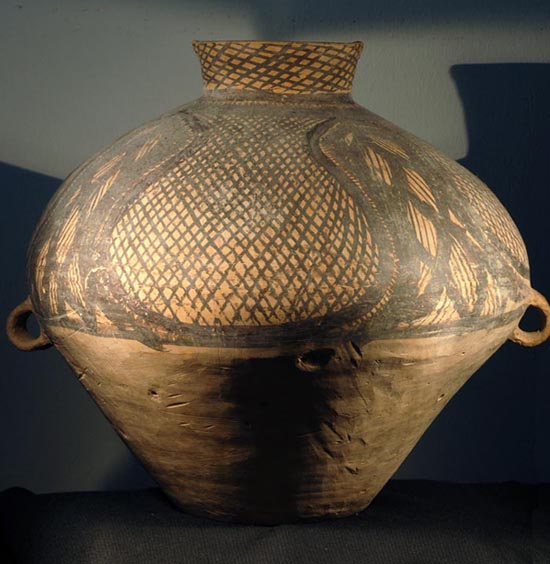|
Neolithic Painted
Pottery Funerary Urn, Yangshao Culture (4800
BC
-
3000 BC) A
Neolithic
Yangshao
culture painted pottery funerary Urn. Urns of this
basic design are widely found and similar designs were adopted in other
areas. These funerary urns predate the invention of the potter's wheel
and were made using long cords of clay wrapped in circles and worked by
hand. The vessel is 30 cm. tall and 33 cm. wide.

Yangshao culture (ca. 4800–ca. 3000 B.C.)The Yangshao archaeological culture is well known for its painted pottery. It consisted of hundreds of settlements along the Yellow River and Wei River regions, and stretched across the northwestern plains from Shaanxi province in central China to Gansu province in the west. Material finds discovered at Yangshao culture sites include a variety of earthenware shards and vessels, many of which were decorated with painted designs. The paint used to decorate these pots is a fluid mixture of the same clay material as the pottery with added mineral pigments. By about 3000 B.C., the painted decoration begin to show undulating lines, fluid contours, and tapered endings, which indicate the use of a flexible brushlike tool. Wide-mouth bowls and basins with flat bottoms were commonly built by stacking coiled strips of rolled clay that were then smoothed before firing. This technique produced vessels characterized by a gently swelling silhouette with the upper register of the body slightly contracted below an everted rim. Such wares were used in daily life and for burial purposes. Yangshao culture in central China can be divided into two main phases: Banpo (ca. 4800–ca. 4300 B.C.) and Miaodigou (ca. 4000–ca. 3500 B.C.). The archaeological site at Banpo was located just east of modern-day Xi’an in Shaanxi province. Banpo was discovered in 1953 and excavated between 1954 to 1957. Little is known about the daily lives of the people at Banpo, but excavations have uncovered a settlement covering around 50,000 square feet that included dwelling areas, subterranean storage pits, pens for holding livestock, several pottery kilns, and cemetery areas. The settlement was also located above a stream that provided a reliable water source, and terraces were built to prevent flooding. The Miaodigou
phase is named after a site in northwestern Henan province. The type of
ceramic produced in this phase was commonly decorated with painted
black lines, dots, leaf-like shapes, and roundels. This decorative
vocabulary appears to be the basis for designs on later Miajiayao
culture pottery. (from Princeton
University
Asian
Art)
References Examples: http://www.christies.com/LotFinder/lot_details.aspx?intObjectID=5184848 Info: Britannica.com A map of early Neolithic cultures in China.
|
